Mashinky: Advanced connections and stations
Last update:
Read more about train connections:
- One-direction loop for two and more trains
- Two-lane road with semaphores for a few trains
- Crossroads and connecting side lines
- Entrance and exit from a station with high train traffic
One-direction loop for two and more trains
One-direction loop is a route that combines two or more stations and is used for servicing more trains. A full fluency of the trains is a strong advantage of this solution. The disadvantage lies in hardship with modifying the line and the time it takes to go back. The longer the loop, the more time it takes for the trains to go back to the starting station. In addition to that, the loop must feature trains with similar speed and length. Longer and heavier trains will block shorter and lighter trains. In such case you can frequently see faster trains riding slowly behind slower ones.
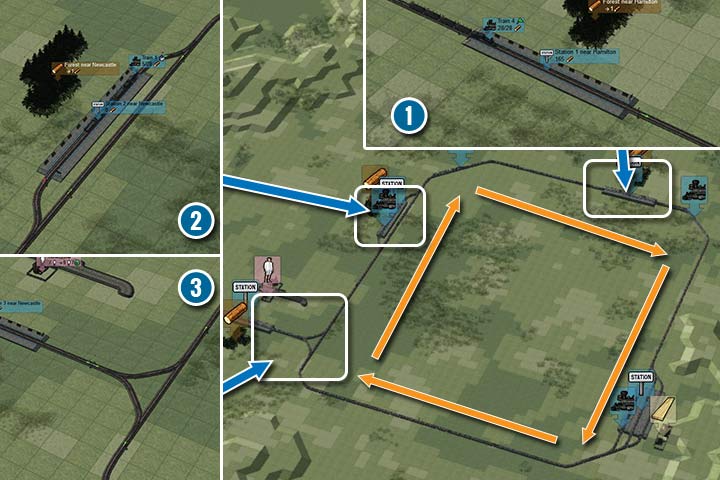
Combine all stations in such a way that you create a closed circuit. Then place semaphores in equal distances. The distance should equal the length of the trains that will use the road. The semaphores must be one-directional (all turned in the same direction). Place a semaphore before each station, even if it means a shorter or longer section. First release and observe two trains on the road, then try adding another train. If the fluency is still maintained, you can still experiment with more trains or leave it as it is.
The placement of the stations is important in such connection. There are a few possibilities:
- Station on the track (1). You will minimize the number of tracks required for construction. Trains that don't need to visit the station will simply pass by it. On the other side, if one train stops here, the rest will stay before the station.
- Station next to the track (2). Construct the station in parallel to the main loop. A train will drive from the route without blocking it. However, when the main track is blocked, the trains will use the parallel route as a shortcut, which means they can still block the station for other trains.
- Station-branch (3). You create a small branch from the main loop with a two-directional semaphore (or you place two one-directional semaphores, each in every direction). Although the trains waste time on reaching the station, they won't block the main route and the whole line will become more fluent. The disadvantage is that the station can service only one train if you placed one platform (with two-directional semaphores) or not more than two (with one-directional semaphores). The problem can be solved by adding more platforms.
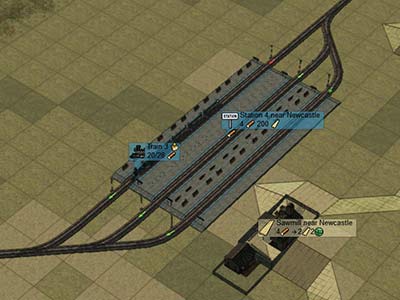
Additionally, the destination station (processing plant, factory) can have a few stations. Such station is connected to the main line and it has semaphores before and after each platform. Usually it will be the destination of all your trains. Instead of forcing the trains to wait, you can simply speed up the unloading time and increase the fluency of the loop. Simply add a few platforms to the station.
Two-lane road with semaphores for a few trains
Constructing two parallel routes can greatly improve the traffic for even a dozen of trains. You can construct such route for short and long connections. The only disadvantage is the building cost and time you must spend on setting the signalization.

Start with building a station with a few platforms and connecting two lines of tracks to these places. Place one-directional semaphores on both lines, in equal distances. You should stick to the rule that one side keeps one direction. Thanks to that you will create a road that many trains can use to move in various directions. Place two-directional semaphores before the stations so that the trains can enter and leave the same route.
Another advantage is the possibility to connect many stations that are on the way, to the main line. In such case you should remember to connect to the track on both sides and to place additional semaphores. When needed or new industrial points are unlocked on the map, simply connect them to the main road.
Crossroads and connecting side lines
When building crossroads, you must remember to connect all tracks so that no train will lose its route. By doing so you will create a line to which you can connect other connections - they will always find their route to the target. Creating crossroads is useful when you have two two-line tracks that intersect each other or when you must create branches.
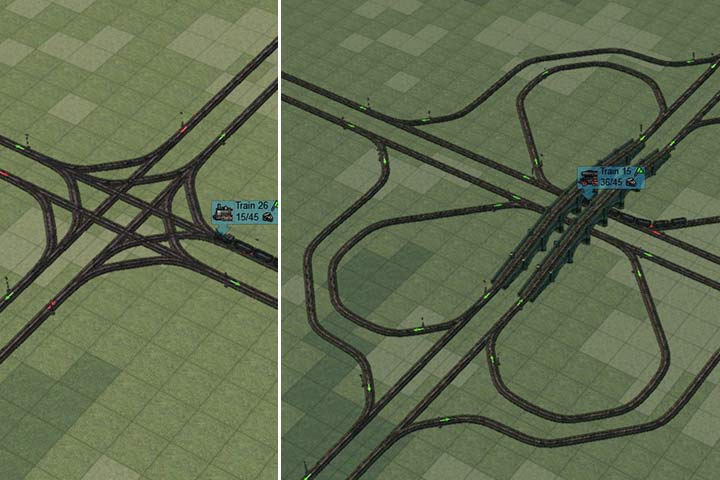
Creating a track-based crossroad is simple, but highly uneconomical. Trains will block on many rails, quickly creating queues. It is best to use bridges or tunnels. Thanks to the upgrades you can create crossroads in which the trains won't be getting in each other way. One route uses regular rails, another goes above them through a bridge or underground through a tunnel. Such option greatly speeds up the journey. You will also avoid any jams or accidents. Remember to combine exterior tracks to the intertwining road, like on highway exits.

Connecting smaller side lines is very simple. Simply drag two lines to railroads to a station and add semaphores before the main line (1). A strong disadvantage of such action is the creation of a crossroad that can stop a few trains. Here it is better to use a bridge or a tunnel (2). In that case one side can branch from the main track and the other can be taken to the other side with bridge or tunnel. This enables you to connect additional line to the main line with no trouble.
Entrance and exit from a station with high train traffic
When building larger and larger connections, you will notice traffic jams near stations. More platforms aren't always solving the problem as frequently the trains will return to the passing loop/second railroad. Because the semaphores divide space into blocks, the part between the main road and the station will be frequently blocked. With many trains or even with few but fast trains you will need a different solution.
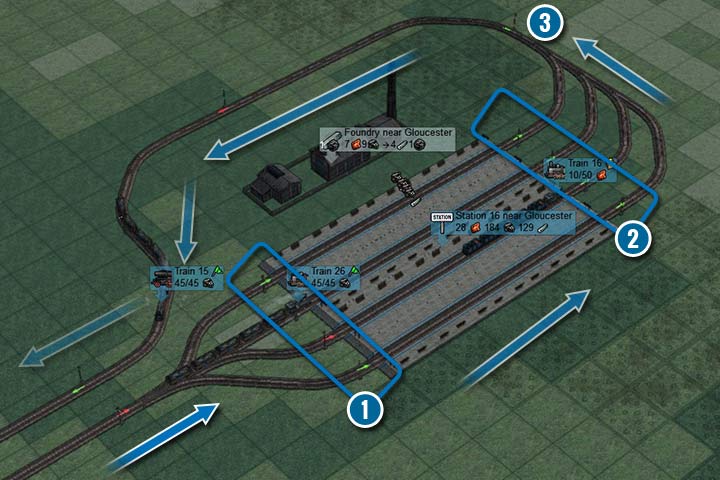
The best solution is to create entry lines and rebuilding the entrance to the station. You change the semaphores before the station from two-directional ones (1) to one-directional towards the station. On the other side you create tracks and add another line of semaphores (2). Now you combine all exits to one track that leads back to the main line at the entrance (3). Now trains won't be turning around and blocking trains entering the station. What's more, when one train will unload cargo, another can enter a different platform. It is one of the best solutions that greatly unload traffic even on the most crowded routes. The only disadvantage is when all platforms are busy and the trains will have to wait for the exit route to be free.
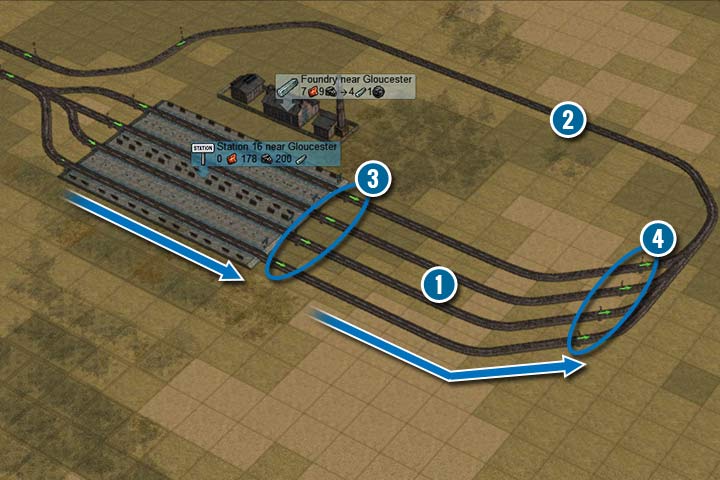
Adding platforms and exit routes might not be enough to solve the problem. Create a line with the length of the trains behind the station (1) and then create a route that connects into the main road (2). Now add semaphore behind the station (3), before the connection to a single line (4). Thanks to that, even if all stations are busy, the trains will leave the platform and will wait on the waiting line. The platform behind them will be left open and other trains won't have to wait for a train to leave the station.
- Mashinky Game Guide
- Mashinky: Game Guide
- Mashinky: Building and management
- Mashinky: How to construct railroads?
- Mashinky: How to effectively build stations?
- Mashinky: Simple connections and stations
- Mashinky: Station upgrades
- Mashinky: How do the semaphores work?
- Mashinky: Plant and factory upgrades
- Mashinky: Advanced connections and stations
- Mashinky: Transshipment stations
- Mashinky: Bridges or tunnels
- Mashinky: Building and management
- Mashinky: Game Guide
You are not permitted to copy any image, text or info from this page. This site is not associated with and/or endorsed by the developers and the publishers. All logos and images are copyrighted by their respective owners.
Copyright © 2000 - 2025 Webedia Polska SA for gamepressure.com, unofficial game guides, walkthroughs, secrets, game tips, maps & strategies for top games.
